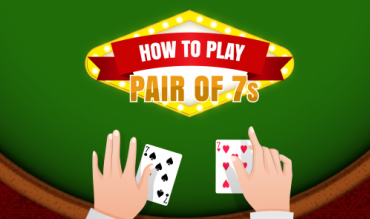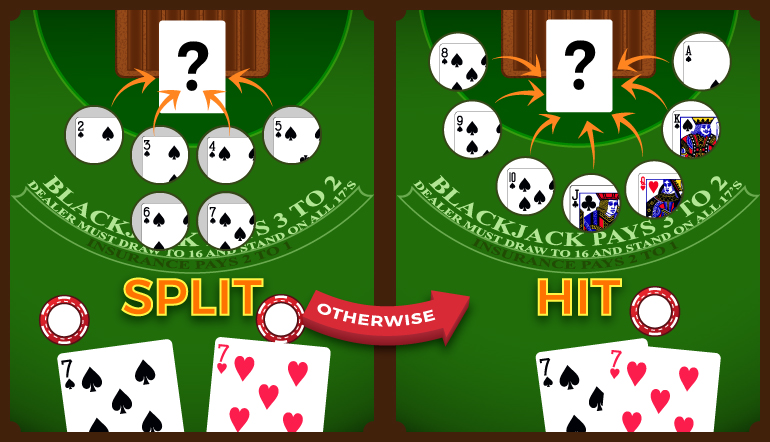
When you are dealt a pair of 7s in blackjack you have four viable playing options:
- Hit
- Split
- Surrender
- Stand
How to play blackjack with this hand and which strategy you should invoke depends upon what the dealer’s upcard is, the number of decks of cards being used, whether double down after pair splitting is allowed, and whether surrender is offered.
MULTI-DECK PLAYING STRATEGY
The basic playing strategy for multi-deck games is to split 7s against a dealer’s upcard of 2 through 7; otherwise hit.
Note: The following abbreviations are used in the following color-coded charts.
P = Split
H = Hit
Sus = Surrender if allowed, otherwise Stand
Suh = Surrender if allowed, otherwise Hit
| 2 | 3 | 4 | 5 | 6 | 7 | 8 | 9 | 10 | A |
|---|---|---|---|---|---|---|---|---|---|
| P | P | P | P | P | P | H | H | H | H |
DOUBLE-DECK PLAYING STRATEGY
- You should split against a dealer upcard of 2-8
- Hit against a dealer upcard of 9, 10, and Ace
Double-Deck Games with DAS
| 2 | 3 | 4 | 5 | 6 | 7 | 8 | 9 | 10 | A |
| P | P | P | P | P | P | P | H | H | H |
| 2 | 3 | 4 | 5 | 6 | 7 | 8 | 9 | 10 | A |
| P | P | P | P | P | P | H | H | H | H |
SINGLE-DECK PLAYING STRATEGY
The playing strategy for a pair of 7s in a single-deck game is slightly more complicated because in some cases, you will be standing or surrendering if the latter is allowed. (Although, as a general rule, surrender in a single-deck game is rarely offered in land-based and online casinos, if it is, you need to know when to surrender a pair of 7s.)
If the playing rules are DAS and S17 then:
- You should split against a dealer’s upcard of 2-8
- Hit against a dealer 9 and Ace upcard
- Surrender against a dealer 10 if allowed, otherwise stand
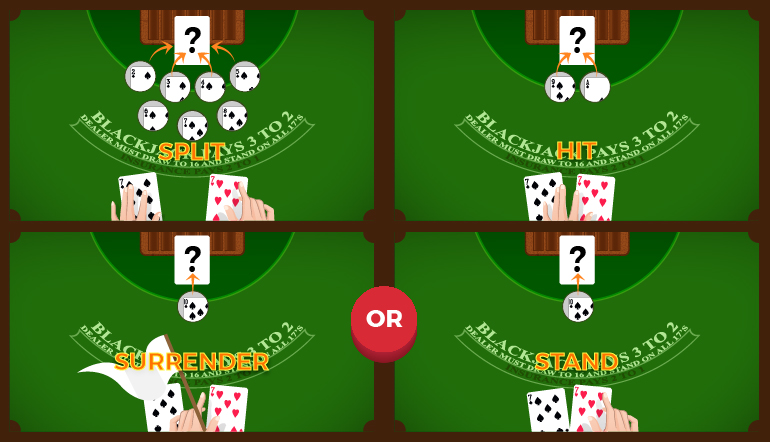
Single-Deck Games with S17 & DAS
| 2 | 3 | 4 | 5 | 6 | 7 | 8 | 9 | 10 | A |
| P | P | P | P | P | P | P | H | Sus | H |
- You should split against a dealer’s upcard of 2-7
- Hit against a live blackjack dealer 8, 9, and Ace upcard
- Surrender against a dealer 10 if allowed, otherwise stand
Single-Deck Games with S17 & NDAS
| 2 | 3 | 4 | 5 | 6 | 7 | 8 | 9 | 10 | A |
| P | P | P | P | P | P | H | H | Sus | H |
If the playing rules are H17 & DAS then:
- You should split against a dealer’s upcard of 2-7
- Hit against a dealer 8 and 9 upcard
- Surrender against a dealer 10 and Ace if allowed, otherwise stand against a 10, and hit against an Ace
H17 and DAS
| 2 | 3 | 4 | 5 | 6 | 7 | 8 | 9 | 10 | A |
| P | P | P | P | P | P | H | H | Sus | Sus |
REASON FOR SPLITTING
- You will win more money on average
- You will lose less money on average
- You will turn a losing hand into a winning hand on average
Suppose you are playing a double-deck game with S17 and NDAS and the dealer’s upcard is a 2. You are the underdog regardless which strategy you invoke; however, splitting has a less negative expectation than hitting, making it the better play. (In other words, you’ll lose less money in the long run by playing two hands, each starting with a 7, than by playing one hand starting with a total of 14.)
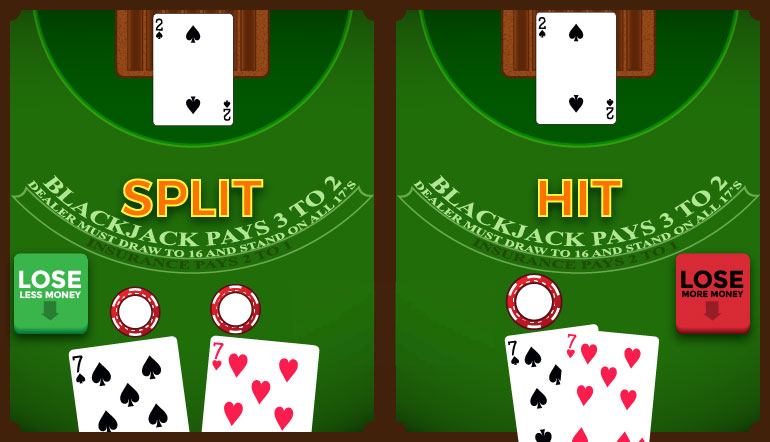
In a single or double-deck game, a non-intuitive play is to split 7s against a dealer 8 upcard when the rules are DAS, and hit when the rule is NDAS. With the favorable option of DAS, when you split 7s and draw, say, a 4 to one or both 7s, you have a favorable total of 11 to double. With DAS, pair splitting becomes a less negative expectation than hitting against a dealer’s 8 upcard, making it the better play.
The reason you surrender a pair of 7s (14) in a single-deck game is because when you hold two sevens against a dealer 10 you would really like to draw another 7 so that your 21 would beat her potential 20. But two of the four sevens have already been removed, making your chances of getting one more seven remote. The result is that surrendering the 7s (14) becomes a better play than hitting (or splitting) in a single-deck game.
You may find the following five rules an easy way to remember how to play your 7s:
- In multi-deck games, always split 7s against a dealer’s 2 through 7, otherwise hit
- In double-deck games, split 7s against dealer’s 2-8 if DAS or 2-7 if NDAS; otherwise hit
- In single-deck games with DAS, split against dealer 2 through 8, and surrender (or stand) against dealer 10 if S17, and surrender against a dealer 10 and Ace if H17, otherwise hit vs. Ace and stand vs. 10
- In single-deck games with NDAS, split against a dealer 2 through 7, and surrender (or stand) against dealer 10 if S17, and surrender against a dealer 10 and Ace if H17, otherwise hit vs. Ace and stand vs. 10
RESPLITTING 7S
If the playing rules allow you to resplit, then it is advantageous for you to do so. For example, if you are dealt a pair of 7s against a dealer’s 5 upcard, you should split them. Suppose on the first 7, you are dealt another 7 on the draw. You should resplit to form a third hand. If the casino allows resplits up to a total of four hands, then you should resplit again if you are dealt another 7. Resplitting pairs is a player-favorable option that you should always take advantage of.
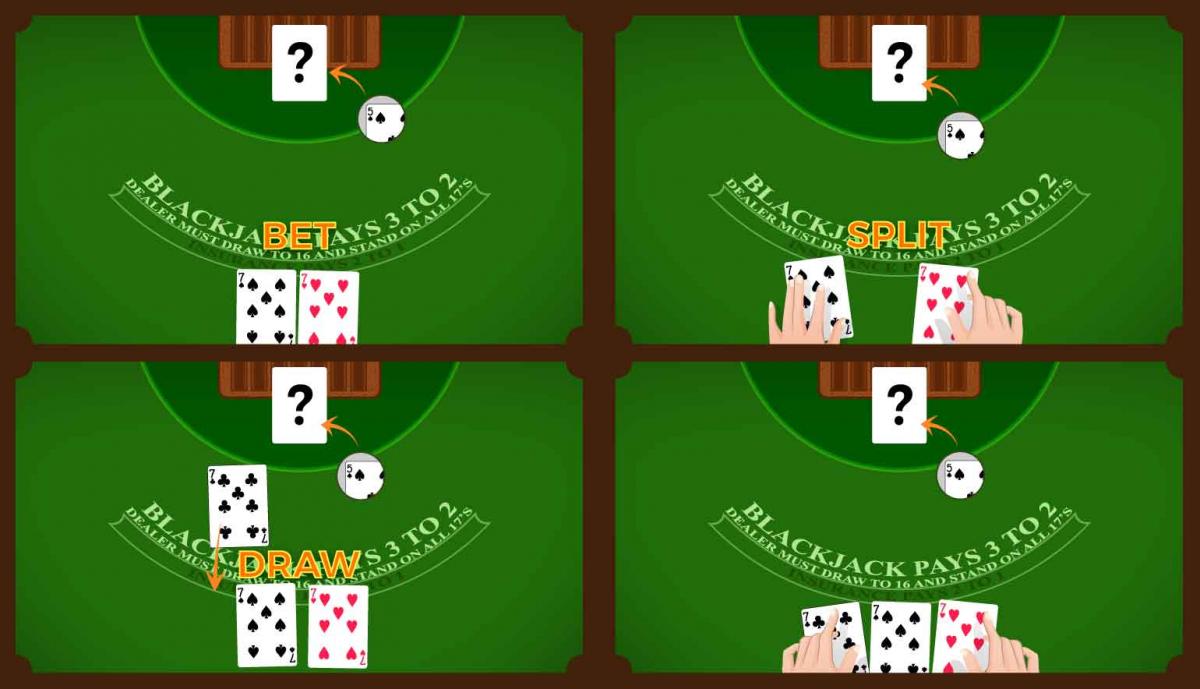
SUMMARY
You will always win more or lose less if you follow the above basic playing strategy for playing a pair of 7s.
For a complete basic playing strategy for any set of playing rules, consult Chapter 3 in the Ultimate Blackjack Strategy Guide.
